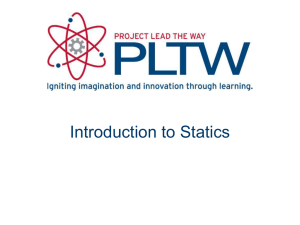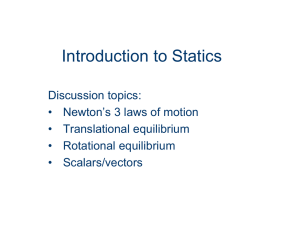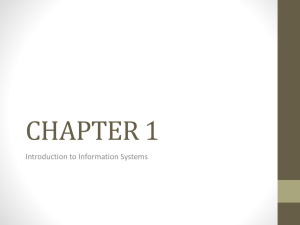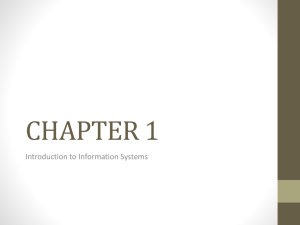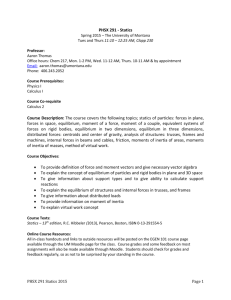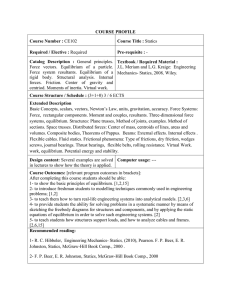Introduction to Statics
advertisement
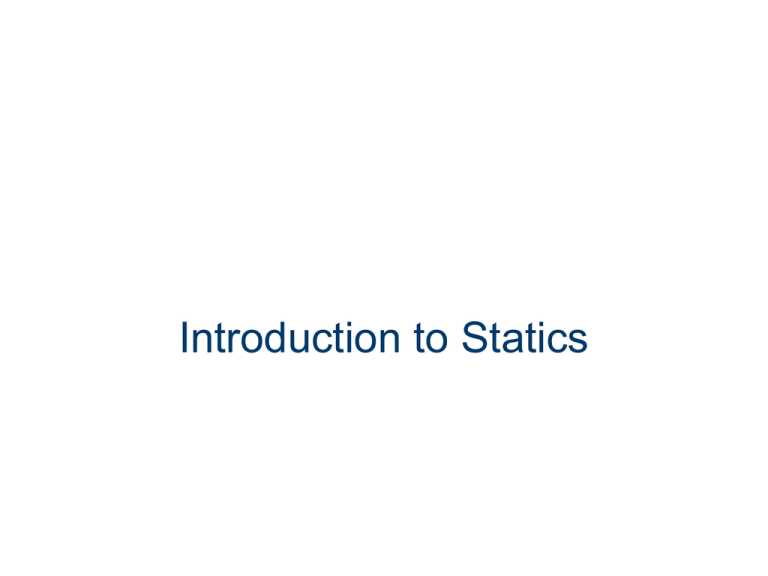
Introduction to Statics Statics The study of forces and their effects on a system in a state of rest or uniform motion ©iStockphoto.com ©iStockphoto.com ©iStockphoto.com Statics Principles Newton’s First Law of Motion (law of inertia): An object in a state of rest or uniform motion will continue to be so unless acted upon by another force ©iStockphoto.com Statics Principles Newton’s Second Law of Motion: The acceleration of an object is proportional to the net force acting on the object and inversely proportional to the object’s mass Force = Mass x Acceleration F = ma Statics Principles Newton’s Third Law of Motion: For every action force, there is an equal and opposite reaction force ©iStockphoto.com Equilibrium Static Equilibrium: A condition where there are no net external forces acting upon a particle or rigid body and the body remains at rest or continues at a constant velocity ©iStockphoto.com Equilibrium Translational Equilibrium: The state in which there are no unbalanced forces acting on a body F =0 F =0 x y ©iStockphoto.com Balanced ©iStockphoto.com Unbalanced Equilibrium Rotational Equilibrium: The state in which the sum of all the clockwise moments equals the sum of all the counterclockwise moments about a pivot point M=0 Remember M = Fd Statics Principles Scalar Quantities: A physical quantity that has magnitude only Examples: Mass, length, ©iStockphoto.com time, volume, temperature, pressure, and speed ©iStockphoto.com Statics Principles Vector Quantities: A physical quantity that has both a magnitude and direction ©iStockphoto.com Examples: Position, velocity, force, and moment ©iStockphoto.com What Is a Force? The pushing or pulling interaction of objects A vector quantity defined by its known magnitude, direction, and point of application A 21.8°NE Force Units British System of Units Pound-force (lbf) International System of Units Newton (N) Conversions between Unit Systems 1lbf = 4.448 N 1N = 0.2248 lbf Static Equilibrium Force Principles Forces always occur in pairs. Force pairs act in opposite directions and have the same magnitude. Force Components A single force can be replaced by component forces if their combination produces the same effect as the original force. Fay a a Fax Resultant Force A single force that has the same effect as two or more concurrent forces Resultant 5lbf 2lbf = Resultant 2lbf 5lbf 7lbf = 3lbf
